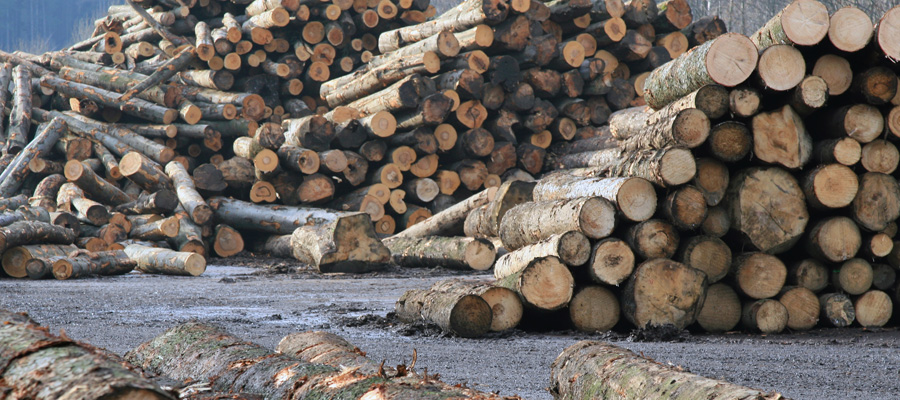The great tree robbery
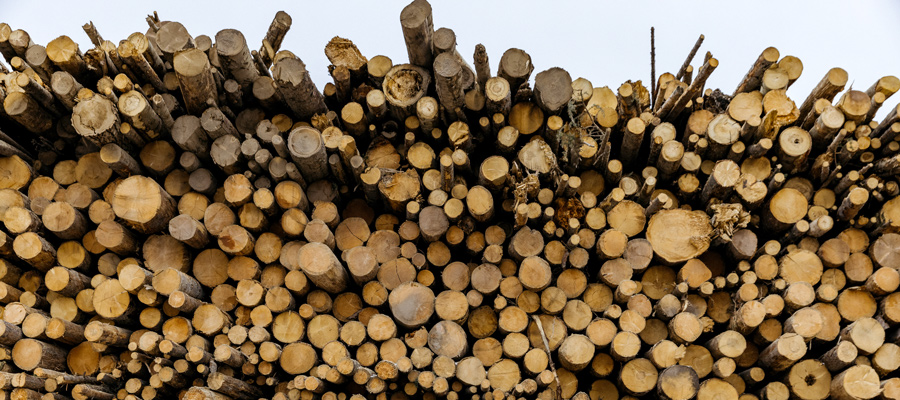
As more old-growth trees topple and forest industry jobs plummet, an obscure government subsidy scheme fuels the collapse
For more than 15 years, the BC government has rewarded logging companies with millions of additional old-growth trees to chop down thanks to an obscure “credit” program that allows companies to log bonus trees that don’t count toward their licensed logging limits.
The virtually unheard of program was noted briefly in a report released by the government in June following a press conference in which Premier John Horgan boasted of his government’s efforts to protect more old-growth forests even as protesters were being arrested in his own riding for blockading logging roads leading into ancient stands of trees.
Despite being a fixture of government policy for a decade and a half, the credits or subsidies, which one former senior-ranking civil servant in the provincial Ministry of Forests likens to a Ponzi scheme, have flown almost completely under the radar.
Under the scheme, which applies across BC’s vast interior region, logging companies that truck lower value trees to wood pellet mills and pulp mills receive credits from the government that allow them to go back into the forest and log as many trees again.
In addition to accelerating the loss of irreplaceable old-growth ecosystems, the bonus logging is certain to fuel even more job losses in BC’s battered forest industry, where 40,000 workers have lost their jobs in the past 20 years. But a new investigation by the Canadian Centre for Policy Alternatives (CCPA) finds even more to be concerned about including:
- No record of how many millions of additional trees have been logged since the subsidies began in 2006, and government refusal to provide such information short of a formal Freedom-of-Information request, which could result in months if not years delay.
- More than $37 million in taxpayer dollars given directly to wood pellet and pulp mills or their suppliers to help underwrite their costs of purchasing lower-quality wood fibre.
- Rapidly rising demand for lower quality logs from BC’s wood pellet mills, which further threatens old-growth forests, despite the industry’s claims to the contrary.
Double dipping
The credits effectively amount to a government-sanctioned double dip for the logging companies. But the biggest consequence may be that the bonus logging is off the books.
In its June report, the government disclosed that the credit logging doesn’t count towards a company’s logging entitlement, known as its Allowable Annual Cut or AAC. That means that one of the only tools the government has to control logging rates—a cap—is badly compromised. There is no record of how many millions of additional trees have been logged since the subsidies began in 2006.
It’s certain, however, that the number is high. In the Prince George area alone, a 2017 report by the province’s chief forester, Diane Nicholls, found that in just one five-year period, logging companies cut down an additional 2.4 million cubic metres of trees under the credit scheme, with much of the downed trees going to the region’s wood pellet mills, a bottom-feeding industry that cares not a whit whether its wood comes from centuries-old or 20-year-old trees.
In the same report, Nicholls, who occupies one of the highest positions in the provincial Ministry of Forests, noted that it is possible that the rate of credit logging will increase even further, resulting in a greater area of forest logged each year. However, she said, the additional logging was an “important tool” to keep lower quality logs flowing to the region’s wood pellet mills, and therefore she would not adjust future logging entitlement (AAC) downwards to reflect the additional number of trees being logged under the subsidy scheme.
In an interview, Anthony Britneff, a former registered professional forester who held senior positions in the same ministry during his nearly 40 years of public service, called the credit scheme “a secretive, fraudulent Ponzi scheme in which the public’s timber is being allocated out of the legislated AAC process.”
He said all British Columbians will be the victims, since the credit logging is happening in publicly owned forests, “and that those responsible should be held accountable.”
“A crime against the province”
Arnold Bercov, a former president of the Public and Private Workers of Canada, said he is deeply unsettled by the subsidy program’s implications. He fears the credit logging will further deepen problems for already stressed forest ecosystems, community watersheds, rural First Nations, non-Indigenous rural communities and forest industry workers alike.
“It’s so bad what we’re doing. We’re liquidating what’s here. That’s what’s going on. And that’s just a crime against this province,” Bercov said.
The union is one of three representing forest industry workers in BC and has been vocal about the need to protect more old-growth forests, and ensure that much higher value is added to whatever trees are logged in the province’s forests.
While Bercov says the credit program poses risks to forests and forest workers alike, its biggest victims will be First Nations on whose ancestral lands all the bonus logging is taking place. “Ultimately, it won’t matter about First Nation land claims. In a few years, it won’t matter if they win or lose because there won’t be anything left to win,” Bercov says.
“Here we are speeding down a climate emergency and we are putting holes in our only lifeboat,” says Suzanne Simard, a professor of forest ecology at the University of British Columbia and author of Finding the Mother Tree: Discovering the Wisdom of the Forest.
Simard said she wonders now how many of the logs “trundling out of the woods daily” near her home community of Nelson in the West Kootenay region may be a result of the credit program, including trees from the interior rainforest, one of the rarest forest ecosystems on earth.
Simard’s concerns are shared by Michelle Connolly, director of Conservation North, an organization devoted to trying to protect the interior region’s primary forests, those forests not disturbed by logging, mining or other industrial activities.
“The BC government is targeting natural hemlock forests in our inland temperate rainforest for pellets even though this ecosystem is red-listed,” said Connolly. “Now we find out that the direct destruction of these rare forests is being subsidized with public money and packaged as a bioeconomy. I really want to know how decision makers sleep at night endorsing this and calling it clean and green.” Here we are speeding down a climate emergency and we are putting holes in our only lifeboat.
Where the trees go, the jobs go
Despite such concerns, the Ministry of Forests, Lands, Natural Resource Operations and Rural Development says that it cannot say how many trees have fallen as a result of the credit program. In an emailed response to a written request from the CCPA, the ministry said that information on credit applications and approvals is largely confined to paper documents and therefore not available. To arrive at a rolled up figure for the total number of credits granted would involve a “large and complex” search that the government won’t even consider doing until it receives a formal Freedom of Information (FOI) request.
“Although some of the information is available electronically, most is housed in other forms that will take time to research and compile,” Doug Kelly, the ministry’s acting executive director of safety, engineering and tenures said in an email.
Short of waiting months if not a year or more to learn how the government would respond to an FOI request and what, if any, documents it would release, the CCPA has tried to gauge the potential scale of the credit program by analyzing publicly available logging data in BC’s interior region for each of the years from 2006, the year the credit began, through 2020.
The vast interior region stretches east of the coast mountains to Alberta and everywhere between BC’s southern and northern borders. Some of the largest sawmills in the world are located in the region, along with pulp mills and a growing number of wood pellet mills.
The combined horsepower of all those mills has escalated demand for trees from the region’s forests, which have been extensively logged for decades as well as being hammered by wildfires and massive beetle attacks that prompted even more logging.
The CCPA analysis identified three notable trends including:
- A 50 per cent increase, on average, since 2006 in logs that could potentially trigger credits. These logs are identified in the database as Grade 4 logs.
- Steady logging of the highest value trees, which yield Grade 1 and Grade 2 logs. Under the credit scheme, a company receiving credits for delivering low-value logs can then use those credits to log higher-value trees.
- A decline in the logging of higher-quality pine trees, and increases in the logging of higher-quality spruce, fir, cedar, hemlock and balsam trees.
The drop in logging of higher-quality pine trees suggests that logging companies have effectively run out of many forests where healthy pine once dominated and are making up the shortfall by intensifying logging elsewhere, including the rare inland temperate rainforest, which scientists warn is on the verge of ecological collapse.
“Collapse” also neatly summarizes forest industry employment, which in 20 years has plummeted from 91,000 jobs to just 49,000 today.
A beetle attack, logging frenzy and mounting wood waste
The credit program has its origins in the epic mountain pine beetle infestation that gathered steam in the interior more than 20 years ago and that killed hundreds of millions of lodgepole pine trees.
The scale, severity and duration of the infestation was made far worse by climate change, but infinitely worse by ill-advised, government-approved clear cutting and tree planting programs.
Those programs saw vast swaths of forest logged and replanted primarily with tiny nursery-raised lodgepole pine seedlings, even though in many cases the forests that had been logged contained a mix of tree species.
Forest scientists including Alex Woods, David Coates and Andreas Hamman were among those to warn early on that the over-reliance on clear cutting and pine planting was a mistake, because the plantations would act as magnets not just for mountain pine beetles but tree-killing blights such as Dothistroma. Scientists warn that the rare inland temperate rainforest is on the verge of ecological collapse.
As more and more of those vulnerable pine plantations began to fail, making a mockery of computer models that confidently predicted that they would maintain their health and vigour, the scientists warned that such plantations had become “a major restoration liability” and would remain so for years if not decades to come.
In response to the epic infestation, the government decided to open the floodgates and allow logging companies to dramatically escalate clear-cut logging in the name of “salvaging” millions of the beetle-attacked trees before they became unusable as feedstock for two-by-fours and other lumber products. But data maintained by the BC government showed that it wasn’t just damaged pine trees that were logged, but millions of healthy spruce, fir, cedar, balsam and hemlock trees as well.
The salvage logging was a bonanza to the interior forest industry and its two undisputed powerhouses, Canadian Forest Products or Canfor and West Fraser Timber, which own and operate some of the biggest lumber mills on the planet.
But it also fueled a surge in wood waste, as millions more trees fell, only to be rejected for hauling to the nearest sawmills because they allegedly lacked the highest quality wood fibre. Making it easier for the companies to leave the rejected logs behind, provincial timber pricing policies required them to pay just 25 cents—the bare minimum—for each cubic metre of lower quality logs left behind, even though many of those same logs could have been made into lumber.
Waste away
The credit program emerged in response to the mountains of wood waste, but it also had roots in the growing demand for wood fibre from an aggressive new player in the forest industry.
In 2006, the nascent wood pellet industry had eight mills in the province and was consuming roughly 2.5 million cubic metres worth of wood fibre a year. In the years to follow, it would grow to 13 mills and its appetite for wood would increase fourfold. And the industry isn’t done growing. Witness a proposal to build what would be the largest pellet mill in Canada in Fort Nelson, a mill that would require the logging of an additional 1.5 million trees per year. Canfor and West Fraser Timber own and operate some of the biggest lumber mills on the planet.
But with surging wood pellet production putting the squeeze on a finite wood supply, it wasn’t long before both pellet mill and pulp mill owners were clamouring for huge numbers of whole logs. With droves of trees being cut down and left where they’d fallen, the challenge became how to convince Canfor, West Fraser and others to bring those logs into town.
Enhancing business conditions
The credit program effectively put fuel in logging truck tanks by rewarding logging companies with the promise of more trees to come.
But there were even more tangible ways that the government subsidized or accelerated old-growth logging. It put money directly into the pockets of the major logging companies and sawmill operators, as well as the wood pellet and pulp companies.
In 2016, a program unveiled by the provincial government created a new entity called the Forest Enhancement Society with an initial infusion of $85 million in taxpayer dollars, later topped up with a second instalment of $150 million.
The society is chaired by former provincial chief forester Jim Snetsinger, who is now a forestry consultant based out of Prince George.
Over the years, the society has doled out money to reforestation and reclamation projects that rehabilitate lands damaged by wildfires and insect attacks. But it has also channeled significant funds into projects that it claims will substantially reduce carbon emissions by bringing lower quality logs and logging debris in from the bush, rather than seeing those logs burned.
After reviewing the society’s lengthy list of funded projects, the CCPA estimates that at least $37 million in taxpayer dollars went directly to wood pellet mills and pulp mills or to companies working to bring lower quality logs and wood fibre into mill towns.
Notable recipients of those public funds included:
- $4.37 million to BC’s biggest wood pellet company, Pinnacle Renewable Energy. Pinnacle is now owned by Drax, a UK company that burns 10 million tonnes of imported wood pellets per year to generate electricity.
- $2.18 million to Pacific Bioenergy, another large wood pellet producer based out of Prince George.
- $1.5 million to the Prince George Pulp and Paper mill.
- $1.25 million to the Domtar pulp mill in Kamloops.
- $3 million to Mercer’s Celgar pulp mill in Castlegar.
In its 2020 “accomplishments” report, the Society states that “one of the biggest challenges” with lower quality logs left behind at logging operations “is that the value of the wood waste is lower than the cost to haul it to a facility like a pellet plant, co-generation electrical plant or pulp mill.”
“Through grants that help cover transportation costs, we support organizations and companies who want to use that leftover wood fibre…instead of burning slash piles, the wood fibre is put to good use and supports our province’s bioeconomy and climate change goals.”
Left completely unsaid is how saving wood from being burned at logging sites only to deliver it to pellet mills that make a product that is then burned equates to a climate benefit. Also left unsaid is the sweet deal that the combined Forest Enhancement Society and credit program subsidies bestowed on the companies involved.
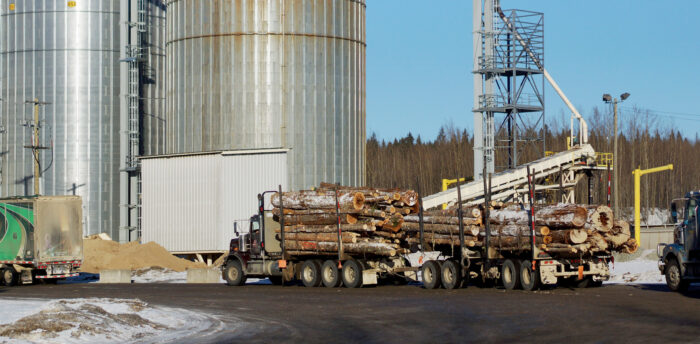
Old-growth cedar logs from one of the world’s most unique and imperilled forest ecosystems—BC’s interior rainforest—make their way into a wood pellet mill yard in Prince George. Photo: James Steidle.
Take as one example, Canfor. Canfor is a partner in the Pacific Bioenergy pellet plant. It also owns the Prince George Pulp and Paper mill.
Through grants received by the society, Pacific Bioenergy and Prince George Pulp and Paper got to underwrite their log purchase costs at taxpayers’ expense, thereby increasing their profits.
Then, after delivering such logs to those facilities, Canfor could apply for credits allowing it to log even more trees, including the higher-value trees that it covets for its sawmill operations.
Credits equal further losses of remnant old-growth
On BC’s coast, the earliest commercial logging dates back to the 1820s, when a sliver of the forest’s tallest and straightest old-growth fir trees were cut down to make ship’s masts. Since then, significant tracts of coastal forest have been logged two or more times. But in the interior, the commercial logging of “primary” or “old-growth” forests, which have never before been clear cut, really only got seriously underway half a century ago.
Because many interior trees are smaller than on the coast, the area of land cleared to yield a similar volume of wood to that on the coast is far greater. Left unsaid is the sweet deal that the combined Forest Enhancement Society and credit program subsidies bestowed on the companies involved.
When the first significant modern era pine beetle infestations began in the late 1980s on the vast Chilcotin plateau west of Williams Lake, the combination of big sawmills and highly automated logging equipment in the form of feller buncher machines resulted in a rapid increase in clear cuts. The even more consequential beetle attacks that followed 20 years later only accelerated the deforestation because by then the sawmills were even bigger.
The consequence? In just 50 years much of the interior’s once-bountiful primary or old-growth forests are gone, with horrendous consequences for endangered wildlife species such as woodland caribou, who need all that the forest contains and where a “low-quality” tree for lumber may be the highest-quality tree for lichen, without which caribou cannot survive. The additional forest losses associated with climate change and its role in fuelling more prolonged and intense wildfires, tree-killing droughts, insect attacks and tree diseases, have further speeded the losses, leading to the deepening ecological and economic crisis.
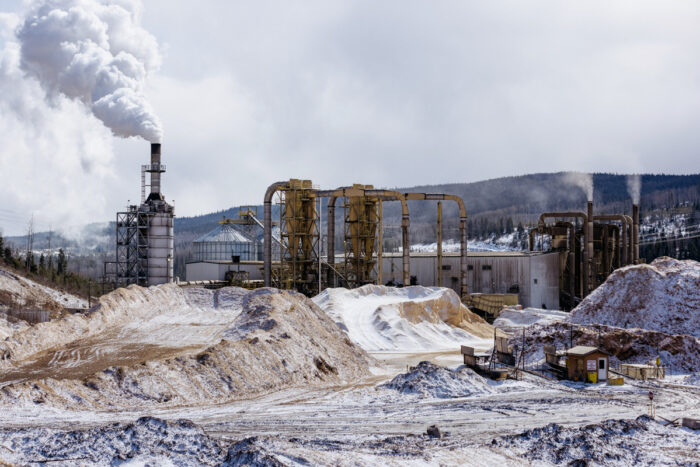
The BC government, which regulates the forest industry, says it cannot say how much government subsidies may be contributing to logs showing up pellet mills, like this one in Burns Lake. Photo: Stand.earth
Double trouble
Earlier this year, the environmental organization Stand.earth released photographs and video footage showing pellet mill yards in Smithers, Burns Lake and Houston filled to overflowing with towering walls of logs.
The images confirmed that contrary to the pellet industry’s assertions that “residual” wood chips from nearby sawmills were the primary feedstock for pellet mills, it was massive numbers of whole logs that kept such operations afloat.
Two of those pellet mills—in Burns Lake and Houston—are in the Nadina Natural Resource District, which is administered by the provincial Forests Ministry.
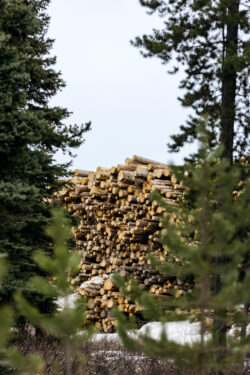
Provincial government subsidies have fuelled additional logging in the Houston area, where logs like this await conversion into wood pellets. Photo: Stand.earth
In addition to the two large pellet operations in the Nadina district, Canfor operates a sawmill in Houston that was the largest mill in the world when it opened its doors in 2004 and remains one of the biggest lumber mills on the planet.
The CCPA analyzed five years of logging data in the Nadina and found that on average the region’s logging companies extracted 14 per cent more trees from the region’s forests than they were entitled to cut under their Allowable Annual Cuts.
Nearly one in every three trees logged during that timeframe were “lower quality” logs that could be used to generate credits, although just how many actually resulted in credits being claimed is unknown because of the government’s refusal to release such information.
Because we don’t know that number, we also cannot say to what extent Canfor and other companies operating in the Nadina may have used the credits as collateral or leverage to get what they really wanted, which was access to the highest-quality old-growth trees.
But what can be said, because the data supports it, is that Canfor and others logged the region’s richest forests at a prodigious clip with two out of every three trees extracted producing Grade 1 and Grade 2 logs.
What can also be said is that any lower quality logs claimed as credits by Canfor in the Nadina district provided a double economic benefit to BC’s largest forest company. As is the case in Prince George, where it is a partner in the Pacific Bioenergy pellet plant, Canfor has a stake in the Houston pellet mill, where it is a co-owner and operator along with Pinnacle Pellet and the Moricetown Indian Band.
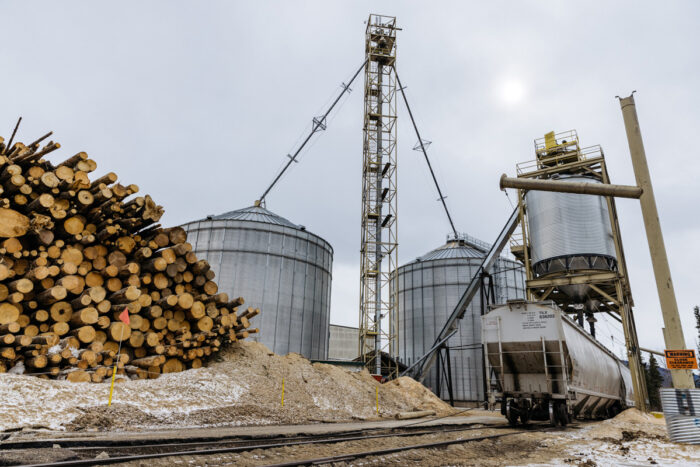
In Houston, Canadian Forest Products (Canfor) operates one of the world’s largest sawmills and is also a partner in the local wood pellet mill. Logs seen here, will be chipped to make wood pellets at the Houston pellet mill. Photo: Stand.earth
In the absence of a proper accounting from the government, it remains uncertain how much the credit program contributed to the Allowable Annual Cut being exceeded for five years running in the Nadina district. It is also uncertain how much the credit program has contributed to the increasing clip at which logging companies throughout the entire interior region have cut down the highest quality trees. In 2011, 39 per cent of all the trees cut down by Canfor and others yielded the highest quality logs. Every year thereafter that number increased to reach 59 per cent of the total at the end of last year. Just how many lower quality logs actually resulted in credits being claimed is unknown because of the government’s refusal to release such information.
And we all fall down
At more than 6.4 million hectares in size, the Mackenzie Timber Supply Area (TSA) surrounding much of the massive Williston Reservoir is one of the largest forested administration zones in BC and larger in size than many European countries.
But the once prosperous community of the same name is a shadow of its former self.
As Mackenzie’s forest industry built up in the 1970s, jobs were so plentiful that workers were firmly in the driver’s seat. They could quit a job in one of the town’s mills in the morning and be working at another mill in the afternoon.
Nearly 2,000 workers were once employed in one of Mackenzie’s five sawmills, two pulp mills, one paper mill, a value-added mill and a chip plant.
Today only one sawmill remains, employing roughly 300 people (although the mill has been taking periodic shutdowns) along with the value-added mill, which employs a little more than 100 people in an operation that takes short trim ends from lumber mills and fits and glues them together in a process called “finger-jointing” to make longer finished boards.
So decimated is Mackenzie’s once vibrant forest sector, that the value-added mill now imports trim ends from mills eight or more hours away.
Peter Merkley is president of Local 18 of the Public and Private Workers of Canada, which recently lost 211 members who worked at Canfor’s last remaining sawmill in Mackenzie. The mill closed its doors for good on June 17, 2019.
The union used to represent upwards of 800 mill workers in Mackenzie. Today, not a single union member is employed in the town.
Adding to the angst of those who cling to the increasingly dim hope of a resurgence in local forest industry activity, Mackenzie’s remaining residents watch as logging trucks by the thousands truck logs past their doors to sawmills starved for logs in Prince George, Quesnel and elsewhere.
Last year, according to data analyzed by the CCPA, Canfor pulled more than 425,000 cubic metres of logs out of the Mackenzie TSA, with a healthy 43 per cent of all those logs being the highest quality Grade 1 and Grade 2 logs.
Merkley equates the activity to strip mining. And he now fears no forest or community will be spared.
“It’s going to happen everywhere, without a doubt, until there’s nothing left. And then, the companies are going to be out of here. It’s disgusting. And our government’s letting it happen, which is beyond me.”
Topics: Economy, Employment & labour, Environment, resources & sustainability, First Nations & Indigenous


